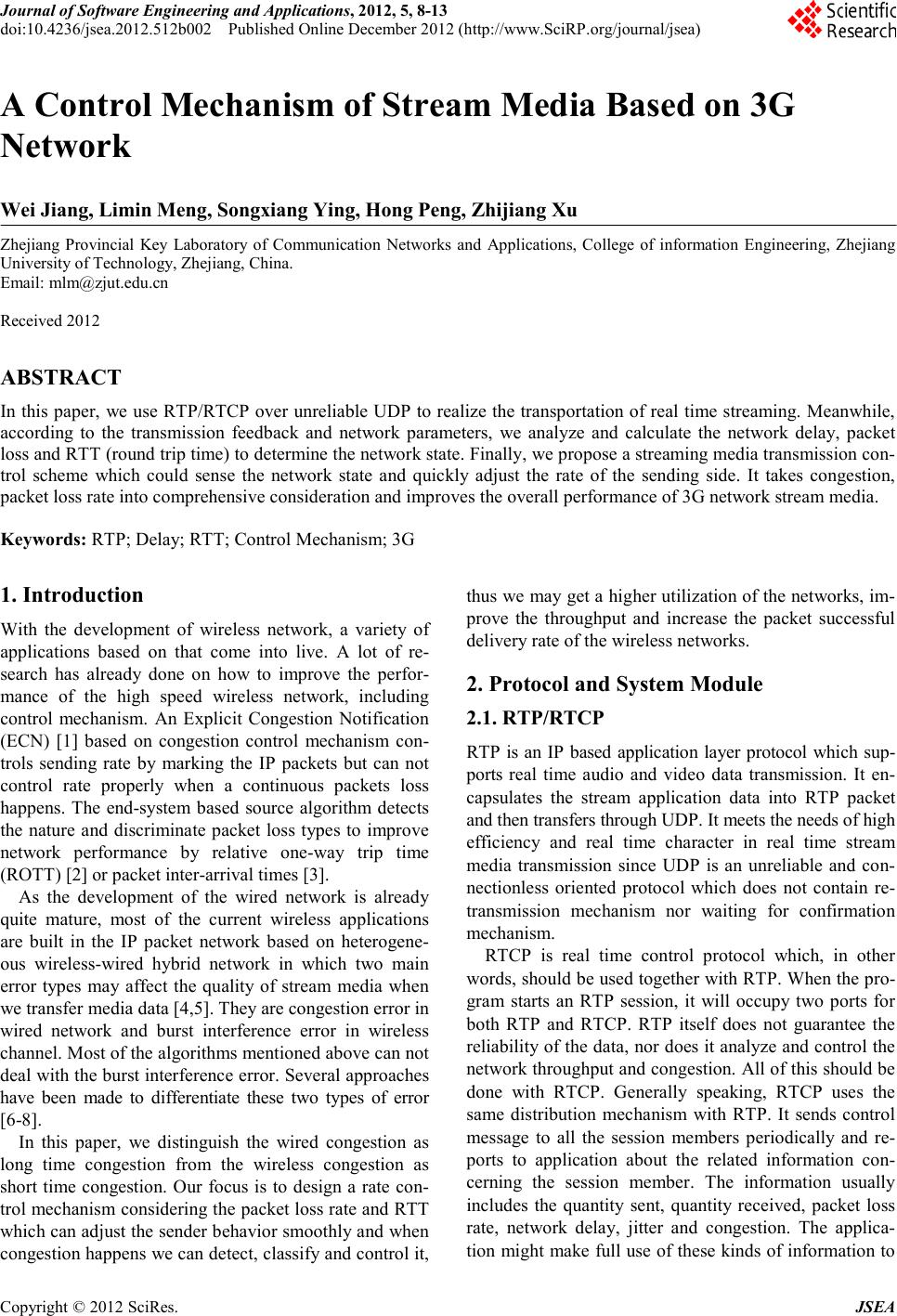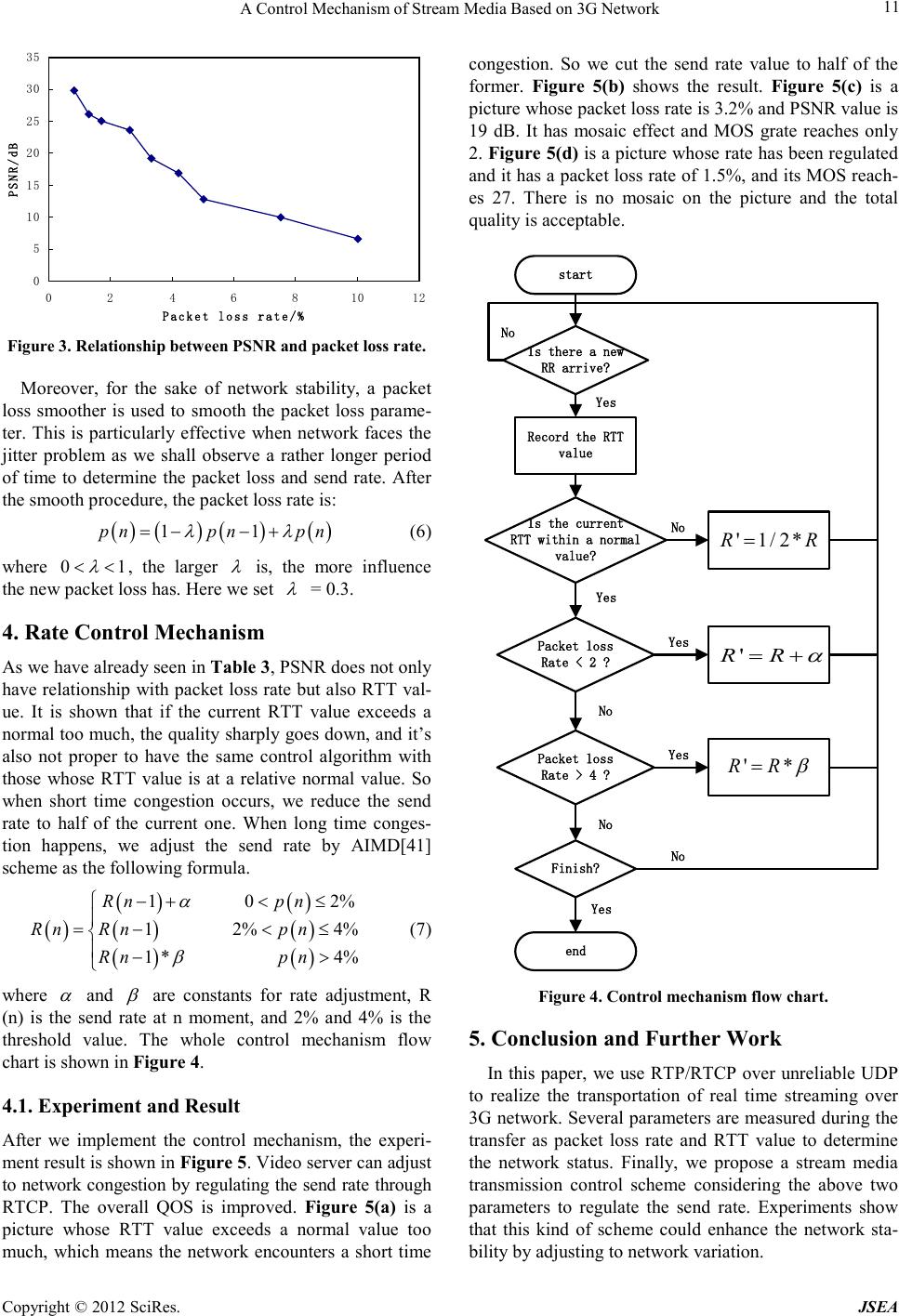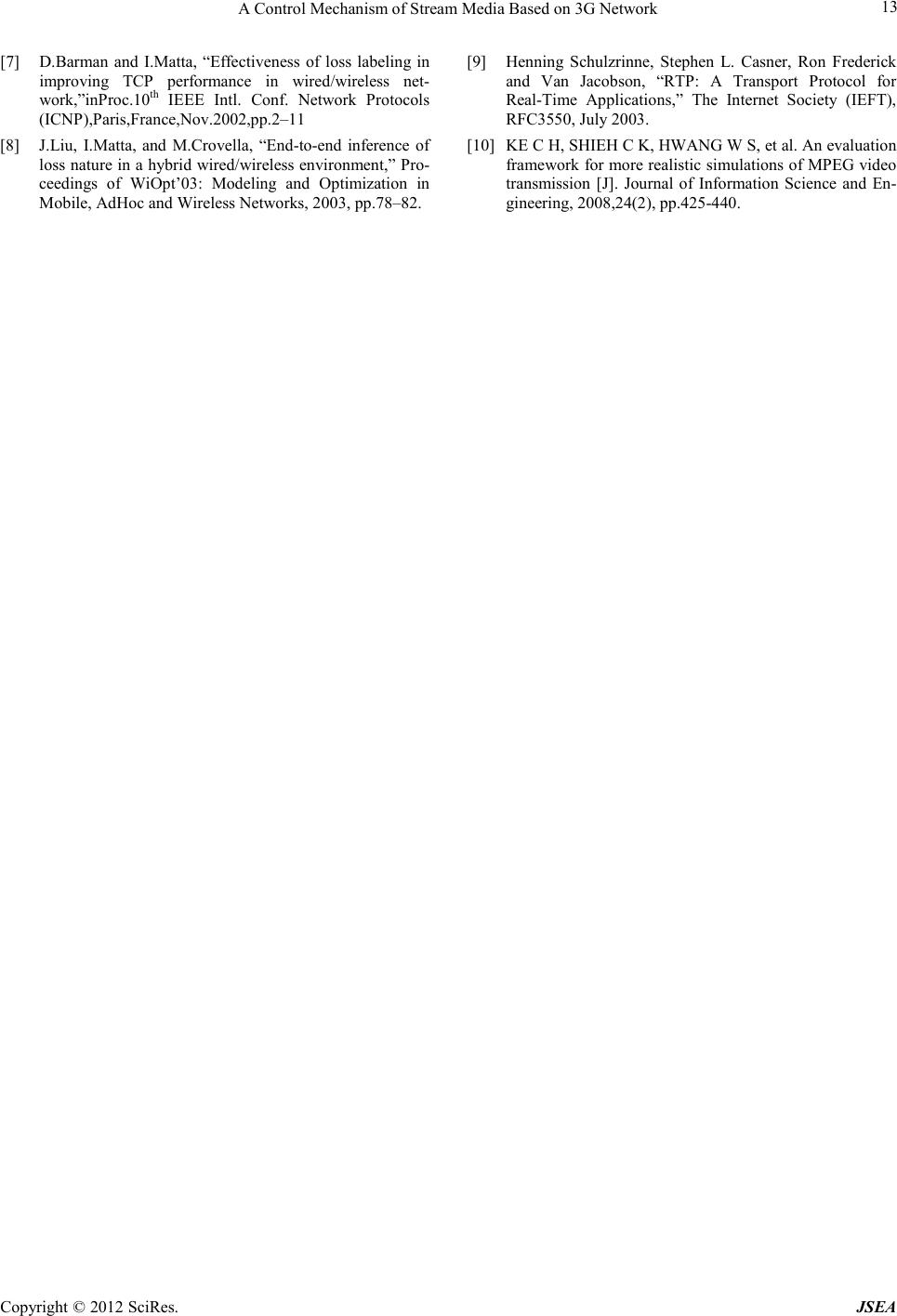Paper Menu >>
Journal Menu >>
 Journal of Software Engineering and Applications, 20 12, 5, 8-13 doi:10.4236 /js ea.2012.512b002 Published Online December 2012 (http://www.SciRP.org/journal/jsea) Copyright © 2012 SciRes. JSEA A Control Mechanism of Stream Media Based on 3G Network Wei Jiang, Limin Meng, Songxiang Ying, Hong Peng, Zhijiang Xu Zhejiang Provincial Key Laboratory of Communication Networks and Applications, College of information Engineering, Zhejiang University of Technology, Zhejiang, China. Email: mlm@zjut.edu.cn Received 2012 ABSTRACT In this paper, we use RTP/RTCP over unreliable UDP to realize the transportation of real time streaming. Meanwhile, according to the transmission feedback and network parameters, we analyze and calculate the network delay, packet loss and RTT (ro und trip time) to dete rmine the net work state . Finall y, we pr op ose a stre aming media tra ns mission co n- trol scheme which could sense the network state and quickly adjust the rate of the sending side. It takes congestion, packet loss rate into comprehensive consideration and improves the overall performance of 3G network stream media. Keywords: RTP; D e la y; RTT; Co ntrol Mechanis m; 3G 1. Introduction With the development of wireless network, a variety of applications based on that come into live. A lot of re- search has already done on how to improve the perfor- mance of the high speed wireless network, including control mechanism. An Explicit Congestion Notification (ECN) [1] based on congestion control mechanism con- trols sending rate by marking the IP packets but can not control rate properly when a continuous packets loss happens. The end-system based source algorithm detects the nature and discriminate packet loss types to improve network performance by relative one-way trip time (ROTT) [2] or packet inter-arrival times [3]. As the development of the wired network is already quite mature, most of the current wireless applications are built in the IP packet network based on heterogene- ous wireless-wired hybrid network in which two main error types may affect the quality of stream media when we transfer media data [4,5]. They are congestion error in wired network and burst interference error in wireless channel. Most of the algorithms mentioned above can not deal with the burst interference error. Several approaches have been made to differentiate these two types of error [6-8]. In this paper, we distinguish the wired congestion as long time congestion from the wireless congestion as short time congestion. Our focus is to design a rate con- trol mechanism considering the packet loss rate and RTT whic h can a dj ust t he se nde r b ehavi or s moo thl y and whe n congestion happens we can detect, classify and control it, thus we may get a hig her uti liza tion of the ne twor ks, i m- prove the throughput and increase the packet successful delivery rate of the wireless networks. 2. Protocol and System Module 2.1. RTP/RTCP RTP is an IP based application layer protocol which sup- ports real time audio and video data transmission. It en- capsulates the stream application data into RTP packet and the n trans fers throu gh UDP. It meets t he needs of high efficiency and real time character in real time stream media transmission since UDP is an unreliable and con- nectionless oriented protocol which does not contain re- transmission mechanism nor waiting for confirmation mechanism. RTCP is real time control protocol which, in other word s, sho uld be used to gether with RT P. Whe n the pro- gram starts an RTP session, it will occupy two ports for both RTP and RTCP. RTP itself does not guarantee the reliabilit y of the data, nor d oes it analyze and co ntrol the network throughput and congestion. All of this should be done with RTCP. Generally speaking, RTCP uses the same distribution mechanism with RTP. It sends control message to all the session members periodically and re- ports to application about the related information con- cerning the session member. The information usually includes the quantity sent, quantity received, packet loss rate, network delay, jitter and congestion. The applica- tion might make full use of th ese kinds o f infor matio n to  A Control Mechanism of Stream Media Based on 3G Network Copyright © 2012 SciRes. JSEA 9 adjust network state for the sake of media QOS (quality of service). The detailed information of RTP/RTCP is shown in RFC 3550[9]. 2.2. System M odul e Stream media transmission system is the core of the whole s ys tem and it s ma i n j o b is t o gua rante e a high effi- ciency stream media transmission. To achieve that, there must be an interactive scheme between server and client which could provide a better QOS under all the circums- tances. Figure 1 shows the stream media transmission system module. Front end audio and video data are en- capsulated into RTP packet which would be stored and transmitted in the send buffer. This process is regulated through RTCP in order to prevent the network conges- tion. While the client receives the RTP packets, it puts them i nto rece ive buffer for resto ring and analyzi ng. The restored data is sent to decoder for audio and video and the analyzed data is built into an RTCP packet to the sender for feedback. 2.3. Network Par ameters Black screen, mosaic, image pause, buffering phenomena often occur in the process of stream media services which strongly reduce the service QOS. Many factors contribute to these cases among which network conges- tion and packet loss are the main causes. In order to improve the QOS of stream media, we take network parameters as real time transmission condition and d ynamica lly cha nging b asis . During t he trans missio n, stream server gathers RTCP data periodically and calcu- lates the QOS parameters. Sender receives RR (Receiver Report) and analyzes the current state of the network, then promptly adjusts the rate of media by changing the resolution and frame rate. The packet loss rate is defined as the ratio of the num- ber of the missing data packet and sending data packet. Defin e the packet loss rate and the number of packets expected . Before the moment t, the receiver got the maximum and minimum sequence of RTP packet as and , so here we have: (1) Suppose in reality the number we get the RTP packet is and the lost , then: (2) From the above, we get the packet loss rate: (3) RTT value calculation: After the SR arriving, receiver sends an RR for feed- back. We define the delay between the SR and RR as DLSR (delay since last SR). We get LSR (last SR time- sta mp) fro m the NT P of SR a nd p ut LSR a nd DLS R into the corresponding RR field. Suppose at moment A the receiver receives SR, then the one-way delay is (A-LSR). The receiver sends the RR at time B , the n DLS R is B -A. Finally the sender receives the RR at time TB, then the RTT value can be calculated: (4) 3. Stream Media Control Mechanism The streaming tra nsmission co ntrol is mainly reflected in the media sending rate adjustment according to the net- work conditions. We mainly focus on reducing packet loss rate and the probability of congestion to achieve a higher quality of video. Figure 1. Str eam media transmission system mo du le.  A Control Mechanism of Stream Media Based on 3G Network Copyright © 2012 SciRes. JSEA 10 3.1. Image Quality Determination For long time congestion, packet loss is mainly due to network overload, so packet loss rate can be used as the basis of long time congestion. For short time congestion, large value of RTT is always expected, so we detect RTT value as the basis of short tim e congesti on. First, let’s take long time conge stion into conside ratio n. We define the network parameters’ threshold according to the image quality requirement. These values include packet loss rate and jitter etc according to which the network status can be classified into three categories. They are under-loading, full-loading and over-loading. Let M and N be the two threshold values for the three states. When packet loss rate is less than M, it indicates that the net work is under-loading, so we can increase the sending rate to acquire a higher QOS. When packet loss rate is between M and N, it means the network is full-loading and we don’t have to change the sending rate. But when packet loss rate is more than N, we should slow down the sending rate to convert the over-loading network to a normal level. Fi g ur e 2 shows the relation- ship between network status and packet loss rate. Packet loss rate directly affects the quality of picture which can be determined by PSNR (Peak Signal Noise Ratio) and MOS (Mean Opinion Score) [10]. PSNR is defined as follow: ( ) ( )( ) col row peak 2 00 col row PSNR 20lg 1,, ,, NN SD ij n V Yni jYni j NN = = = − ∑∑ (5) The meani ng of each part is shown in Table 1: MOS is widely used in audio and video quality mea- sure ment. T his metho d uses a rithmetic average to get t he system running status of quantitative indicators of sub- jective evaluation. MOS can be divided into 5 grades as grade 5 means the picture is of best quality while grate 1 indicates the picture worst. Table 2 shows the corres- pondence between PSNR and MOS. 3.2. Determine the Threshold Experiment uses multiple H.264 video streams which have been packaged into RTP packets and under multiple random packet loss condition to determine M and N. According to formula (3) and (5) we draw a relationship between packet loss rate and P SNR. Also, we take down the RTT value of each stream. The experiment is rec- orded in Table 3: According to the table, we get Figure 3. F ro m Figure 3 we can see, when PSNR is less than 20 dB, which means packet loss rate is greater than 3%, MOS value is 2, that is to say, the picture quality is very poor. Gener- ally speaking, when PSNR is greater than 20 dB, the video quality is acceptable. On the basis of Figure 3, we select N 4% and M 2%. Under-loading Over-loading Full-loadingPacket loss rate MN100%0% Figure 2. Network status and p acket los s rate. Table 1. Meani ngs of sy mbo l in PSNR. Signal Meaning n Picture sequence number peak V peak 21 k V= − ,k is the number of pixel per bit ( ) ,,Yni j Luminance value of a pixel col N The number of the horizontal pixels row N The number of the vertical pixels Table 2. Relationship between PSNR and MOS. PSNR MOS >37 5(Excellent) 31-37 4(Good) 25-31 3(Fair) 20-25 2(Poor) <20 1(Bad) Table 3. Experiment reco rd. Number of video RTT value (ms) Packet loss rate PSNR (dB) 1 15 0.8 29.8 2 30 1.3 26.2 3 43 1.7 25.0 4 62 2.6 23.6 5 74 3.3 19.2 6 88 4.2 16.8 7 105 5.0 12.8 8 152 7.5 10.0 9 183 10.0 6.6  A Control Mechanism of Stream Media Based on 3G Network Copyright © 2012 SciRes. JSEA 11 0 5 10 15 20 25 30 35 0246810 12 Packet loss rate/% PSNR/dB Figure 3. Relationship between PSNR and packe t loss rate . Moreover, for the sake of network stability, a packet loss smoother is used to smooth the packet loss parame- ter. This is particularly effective when network faces the jitter problem as we shall observe a rather longer period of time to determine the packet loss and send rate. After the smooth procedure, the packet loss rate is: ( )()()( ) 11pnpn pn λλ =− −+ (6) where 01 λ << , the larger λ is, the more influence the new packet loss has. Here we set λ = 0.3. 4. Rate Control Mechanism As we have already seen in Table 3, PSNR does not only have relatio nship with pa cket loss rate but a lso RTT val- ue. It is shown that if the current RTT value exceeds a nor mal too muc h, the qualit y shar ply go es do wn, and it ’s also not proper to have the same control algorithm with those whose RTT value is at a relative normal value. So when short time congestion occurs, we reduce the send rate to half of the current one. When long time conges- tion happens, we adjust the send rate by AIMD[41] scheme as the following formula. ( ) ()( ) ()( ) ()( ) 1 02% 1 2%4% 1* 4% Rn pn Rn Rnpn Rn pn α β −+< ≤ =−<≤ −> (7) where α and β are constants for rate adjustment, R (n) is the send rate at n moment, and 2% and 4% is the threshold value. The whole control mechanism flow char t is shown in Figure 4. 4.1. Experiment and Result After we implement the control mechanism, the experi- ment r e sult i s s ho wn i n Figure 5. Video server can adjust to network congestion by regulating the send rate through RTCP. The overall QOS is improved. Figure 5(a) is a picture whose RTT value exceeds a normal value too much, which means the network encounters a short time congestion. So we cut the send rate value to half of the former. Figure 5(b) shows the result. Figure 5(c) is a picture whose packet loss rate is 3.2% and PSNR value is 19 dB. It has mosaic effect and MOS grate reaches only 2. Fig ure 5(d) is a picture whose rate has been regulated and it has a packet loss rate of 1.5%, and its MOS reach- es 27. There is no mosaic on the picture and the total quality is acceptable. Record the RTT value start Is there a new RR arrive? Is the current RTT within a normal value? Packet loss Rate < 2 ? 'RR α = + ' 1/2*RR= Packet loss Rate > 4 ? '*RR β = Finish? end Yes Yes Yes Yes No No No No Yes No Figure 4. Control mechanism flow chart. 5. Conclusion and Further Work In this paper, we use RTP/RTCP over unreliable UDP to realize the transportation of real time streaming over 3G network. Several parameters are measured during the transfer as packet loss rate and RTT value to determine the network status. Finally, we propose a stream media transmission control scheme considering the above two parameters to regulate the send rate. Experiments show that this kind of scheme could enhance the network sta- bility by adj usti ng to network var iatio n.  Current Distortion Evaluation in Traction 4Q Constant Switching Frequency Converters Copyright © 2012 SciRes. JSEA 12 (a) (b) (c) (d) Figure 5. Experiment result. There are several future works in this paper. Since we have already implemented the algorithm considering packet loss rate and RTT, some other parameters such as jitter and bandwith might be under consideration in the future. 6. Acknowledgement s This work was supported in part by Zhejiang Provincial Key Laboratory of Communication Networks and Ap- plications, College of information Engineering, Zhejiang Unive r sit y o f T e chno l og y, Program for Zhejiang Leading Team of Science and Technology Innovation and Appli- cati ons a nd Zhejiang University of Technology. REFERENCES [1] H.J. Lee, H.J. Byun, J.T. Lim, "TCP-friendly congestion control for streaming real-ti me ap plications o ver wireless networks," IET Communications, 2008, vol. 2, no. I, pp. 159-163. [2] N. Nguyen, E.H. Yang, "End-to-end loss discrimination for improved throughput performance in heterogeneous networks," In: 2006 3rd IEEE Consumer Commu- nications and Networking Conference (CCNC 2006), Las Vegas, NV, January 2006, pp. 538-542. [3] Y. Tobe, Y. Tamura, A. Molano, S. Ghosh, H. Tokuda, "Achieving moderate fairness for UDP flows by path-status classification," In: 25th Annual IEEE Confe- rence on Computer Network (LCN 2000), Tampa, FL, November 2000, pp. 252-261 [4] Mengyue. Chen, “QoS algorithmic research based on wir e d -wireless hybrid network transmission,” master Thesis, Nanjing University of Posts and Telecommunica- tions, Nanji ng , 2007. [5] Yang. Xia, “WVTPx transmission rate control algorithm based on wired-wireless h ybr id network” master Thesis, Nanjing University of Posts and Telecommunications, Nanjing, 2007. [6] S. C en , P .Cos ma n, and G.Voel ker, “End to end differen- tiation of congestion and wireless lo ss,”i nP roc.ACM mu l- timedia Computing Networking, SanJo s e, CA, Jan.2002,pp.1–15.  A Control Mechanism of Stream Media Based on 3G Network Copyright © 2012 SciRes. JSEA 13 [7] D.B arman and I.Matta, “Effectiveness of loss labeling in improving TCP performance in wired/wireless net- work,”inProc.10th IEEE Intl. Conf. Net work Protocols (ICNP),Paris,France,Nov.2002,pp.2–11 [8] J.Liu, I.Matta, and M.Crovella, “End-to-end inference of loss nature in a hybrid wired/wireless environment,” Pro- ceedin gs of WiOpt’03: Modeling and Optimization in Mobile, AdHoc and Wireless Networks, 2003, pp.78–82. [9] Henning Schulzrinne, Stephen L. Casner, Ron Frederick and Van Jacobson, “RTP: A Transport Protocol for Real-Time Applications,” The Internet Society (IEFT), RFC3550, July 2003. [10] KE C H, SHIEH C K, HWANG W S, et al. An evaluation framework for more realistic si mulations of MPEG video transmission [J]. Journal of Information Science and En- gineering, 2008,24(2), pp.425-440. |

